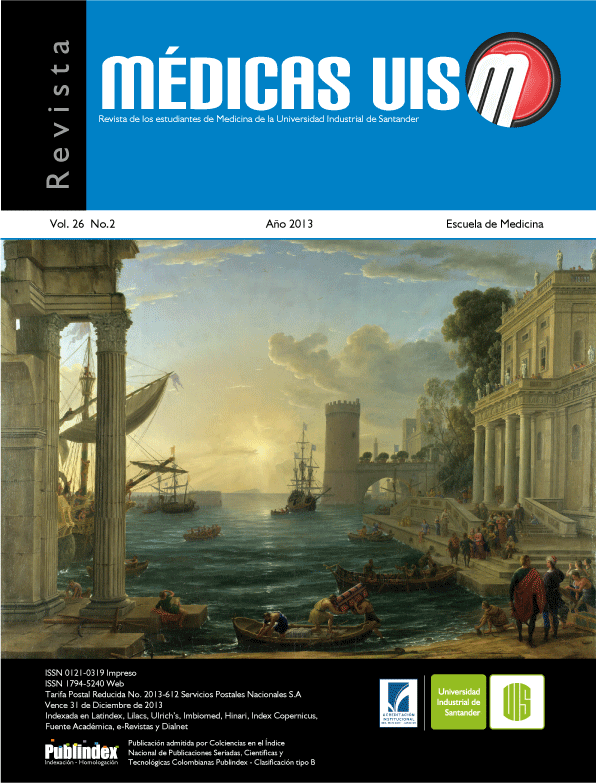Abstract
Background: coronary heart disease is the main cause of death worldwide, and coronary atherosclerosis is responsible of about 90% of ischemic heart events . Objective: review the pathophysiology of atherosclerosis, from the factors that promote endothelial dysfunction,
until the apparition of the diseases secondary to this disease. Conclusions: atherosclerosis is a chronic and complex process that begins during childhood, several mechanisms contributes to atherogenesis including endothelial dysfunction and infammation. A better understanding of the pathogenesis of atherosclerosis will provide us with tools for reducing mortality resulting from coronary artery disease. (MÉD.UIS.2013;26(2):51-7)
References
2. Mather KJ, Lteif A, Steinberg HO, Baron AD. Interactions between endothelin and nitric oxide in the regulation of vascular tone in obesity and diabetes. Diabetes. 2004;53(8):2060-6.
3. Rubio-Guerra AF, Vargas-Robles H, Ramos-Brizuela LM, Escalante-Acosta BA. Is tetrahydrobiopterin a therapeutic option in diabetic hypertensive patients? Integr Blood Press Control. 2010;3:125-32.
4. Alp NJ, Channon KM. Regulation of endothelial nitric oxide synthase by tetrahydrobiopterin in vascular disease. Arterioscler Thromb Vasc Biol. 2004;24(3):413-20.
5. Madamanchi NR, Vendrov A, Runge MS. Oxidative stress and vascular disease. Arterioscler Thromb Vasc Biol. 2005;25(1):29-38.
6. de Winter MP, Kanters E, Kraal G, Hofker MH. Nuclear factor kappaB signaling in atherogenesis. Arterioscler Thromb Vasc Biol. 2005;25(5):904-14.
7. Rubio-Guerra AF, Castro-Serna D, Rodríguez-López L, Vargas-Ayala G, Lozano-Nuevo JJ. Papel de la inflamación y la adhesión leucocitaria en la fisiopatología del daño orgánico en la hipertensión arterial. Medicina Universitaria. 2010;12(48):181-6.
8. Frenette PS, Wagner DD. Adhesion molecules--Part 1. N Engl J Med. 1996;334(23):1526-9.
9. Smith CW, Burns AR, Simon SI. Co-operative signaling between leucocytes and endothelium mediating firm attachments. In: Pearson JD, Editors. Vascular adhesion molecules and Inflammation. Basel; Boston; Berlin: Birkhauser; 1999. p.39-64.
10. Hansson GK. Inflammation, Atherosclerosis, and Coronary Artery Disease. N Engl J Med. 2005;352(16):1685-95.
11. Rubio-Guerra AF, Vargas-Robles H, Medina-Santillán R, Escalante-Acosta BA. Niveles de moléculas de adhesión solubles en pacientes diabéticos tipo 2 normotensos e hipertensos. Gac Med Mex. 2008;144(1):11-4.
12. Galen FX. Cell adhesion molecules in hypertension: endothelial markers of vascular injury and predictors of target organ damage? J Hypertens. 2002;20(5):813-6.
13. Rubio-Guerra AF, Vargas-Robles H, Maceda A, Vargas-Ayala G, Rodriguez-Lopez L, Escalante-Acosta BA. Correlation between the levels of circulating adhesion molecules and atherosclerosis in hypertensive type-2 diabetic patients. Clin Exp Hypertens. 2010;32(5):308-10.
14. Tzoulaki I, Murray GD, Lee AJ, Rumley A, Lowe GD, Fowkes GR. C-reactive protein, interleukin-6, and soluble adhesion molecules as predictors of progressive peripheral atherosclerosis in the general population: Edinburgh Artery Study. Circulation. 2005;112(7):976-83.
15. Libby P, Ridker PM. Inflammation and atherosclerosis: role of C-reactive protein in risk assessment. Am J Med. 2004;116 Suppl 6:9-16.
